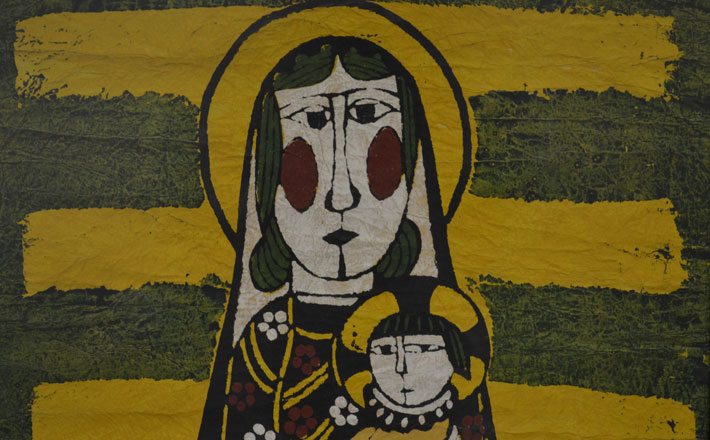Commentary on Hebrews 1:1-4 [5-12]
Christmas is the Festival of the Incarnation.
It celebrates the birth of the baby Jesus. The second lesson for today reminds us, however — as does the Gospel text — that the nativity is set within a larger story of mind-boggling scope. The church traditionally has thought of the larger Christ narrative in terms of three movements — Preexistence (with the Father), descent (Incarnation), and ascent (Exaltation). All three movements are invoked in this magisterial text in ways that resonate with other New Testament Christological hymns (e.g., Philippians 2:5-11). When the Incarnation is in view in this lesson, the priestly work of Christ’s offering of the “purification for sins” (Hebrews 1:3b) is in focus in a way unique to the theology of Hebrews. The birth of Jesus suggests the death of Jesus. Incarnation finds its end in Atonement mediated by one like the mysterious Melchizedek.
The text breaks down into two distinct parts. Hebrews 1:1-4 (a single sentence in Greek) has the structural center in the independent clause: “God has spoken to us in a Son.” Verse 4 introduces the theme of the next section of text (the Son’s superiority to angels) that naturally extends a couple of verses beyond the RCL selection. If the preacher engages the second portion of the pericope, it is best to read through to v. 14: “Are not all angels spirits in the divine service, sent to serve for the sake of those who are to inherit salvation?” The purpose of “angels” (i.e., God’s intermediaries/messengers) is to serve God’s intent and very being. From Hebrews’ perspective, which is that of the New Testament in general, angels are enfolded into the reality of Christ. They serve Jesus (Matthew 4:11). They are among the “principalities and powers” over whom the cross of Christ is triumphant (Romans 8:38; Ephesians 3:10-11; 6:12; Colossians 1:16). They will come with the Son of Man at the end of time when Christ appears in glory (Mark 8:38).
Hebrews 1:1-4 is elegantly written in high Greek style, making much of alliteration, balanced phrasing, chiasm, etc. Not much of this comes over into English translations. In terms of content, this exordium introduces themes that will be explored in various ways in the rest of Hebrews. Verse 1 indicates Hebrews’ understanding that the Christ event is continuous with the revelation of God accessible through the theological narrative of Jewish scripture in Greek translation (the Septuagint or LXX). The composition of the community to whom the author writes is elusive, but it no doubt includes Gentiles. The claim of verse one is, then, that these Gentiles, through baptism, have been incorporated into the people of God and can legitimately claim Israelite ancestry as their own (cf. 1 Corinthians 10:1). Though there is strong continuity with the revelation of what Christians call the Old Testament, God has done something new in Christ. What was spoken “in many and various ways” has now been expressed — singularly — through the Incarnation. Christ is, then, the fulfillment, the completion of all that God’s speech has revealed previously. In fact, the Incarnation is the fulcrum upon which all history turns. It marks the beginning of the eschaton (“in these lasts days”; Hebrews 1:2). In the birth of the Son (the name “Jesus” appears first in Hebrews 2:9), the infinite power of God both to create from nothing and the ability to sustain all things is enfolded. Here rests one of the central mysteries of the Christian faith. Lutherans came to express the paradox by stating that “finite” human Jesus contains the “infinite” being of God (finitum capax infiniti). However one comes to express this mystery, according to Hebrews, Jesus is — unaccountably — both a high priest who is able “to sympathize with our weaknesses … one who in every respect has been tested as we are” (4:15), yet is also “the same yesterday and today and forever” (13:8).
Verse 3 (“he sat down at the right hand of the Majesty on high”) introduces, implicitly, Psalm 110:1, an important text to Hebrews. In its original life-situation, the psalm describes the enthronement ritual of the King of Israel. In its application to the exalted Christ, it describes Jesus’ co-enthronement with God; Jesus is given the “name” (v. 4) — kyrios (“Lord”) — that is “more excellent” than that of even the angels. It is the name the LXX gives to God (see Psalm 110:1; 109:1 LXX; cf. Philippians 2:9).
Hebrews is unique among New Testament documents, however, in that it also sees theological significance in Psalm 110:4, “The LORD has sworn and will not change his mind, ‘You are a priest forever according to the order of Melchizedek.’” This text and its exposition is explicitly engaged later in Hebrews (5:6, 10; 6:20; 7:11, 17). It provides the Old Testament figure of Melchizedek who foreshadows Jesus work as the priest who offers sacrifice once, for the sins of all (7:27).
The second reading for today from Hebrews is well paired with the Gospel lesson (John 1:1-14). They introduce overlapping themes that can be explored by the imaginative preacher in a variety of ways. There is, for example, the light/darkness contrast of John 1:4b-5 that complements the “radiance/reflection” language of Hebrews 1:2. A similar overlap can be seen in Hebrews’ depiction of Jesus in terms of “glory” (v. 2) and that of John 1:14 (“And the Word became flesh and lived among us, and we have seen his glory, the glory as of a father’s only son, full of grace and truth.”). These visions of the Son born to Mary in terms of light, radiance/reflection (apaugasma can mean either), and glory are stunningly apt this time of the year. The darkness that is so overpowering in the Northern Hemisphere is won over by the light of Christ. In terms of the natural rhythms of the sun, the winter solstice is now behind us (December 21). The days will only get longer, nights shorter. Christmas heralds the return of light both to the world (sun) and to the church (Son). The quiet and measured advance of light marked in some parishes by Advent candles, now shines forth clearly and brightly from these texts, literally spoken by God (see introductory formulas of Hebrews 1:5-8) to us. That is something to lift up and celebrate in these dark days of early winter!


December 25, 2014